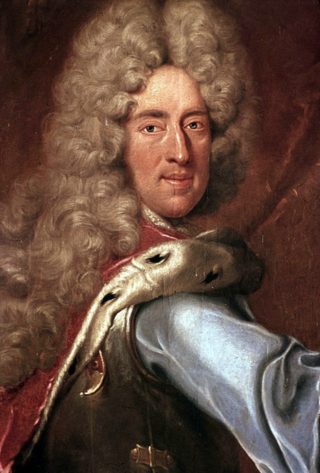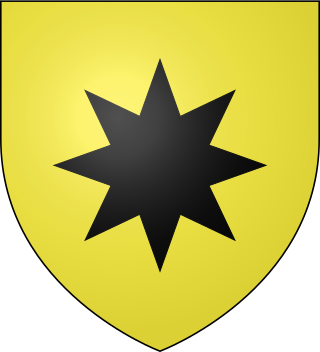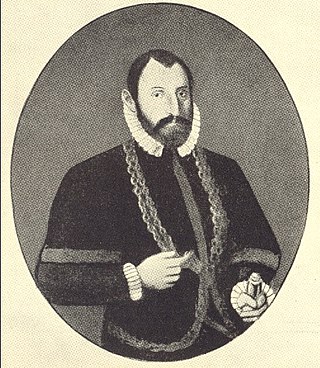
Louis IX of Hesse-Darmstadt was the reigning Landgrave of Hesse-Darmstadt from 1768 to 1790.

Moritz, Landgrave of Hesse was the son of Prince Philip, Landgrave of Hesse, and the head of the House of Brabant and the German House of Hesse.

Christian Louis Casimir, 2nd Count of Sayn-Wittgenstein-Berleburg-Ludwigsburg was a reigning Count of Sayn-Wittgenstein-Berleburg-Ludwigsburg line of Sayn-Wittgenstein family from 1750 to 1796.

Ernest Louis of Hesse-Darmstadt was Landgrave of Hesse-Darmstadt from 1678 to 1739. His parents were Landgrave Louis VI of Hesse-Darmstadt and Elisabeth Dorothea of Saxe-Gotha-Altenburg (1640–1709).

John William III, Duke of Saxe-Eisenach, was a duke of Saxe-Eisenach, and came from the Ernestine line of the House of Wettin.

Louis V of Hesse-Darmstadt was the Landgrave of Hesse-Darmstadt from 1596 to 1626.

George I of Hesse-Darmstadt was the Landgrave of Hesse-Darmstadt from 1567 to 1596.

Wilhelm VI, Landgrave of Hesse-Kassel, known as William the Just, was Landgrave of Hesse-Kassel from 1637 to 1663.

Magdalene of Brandenburg, also Magdalene and Magdalen, was the daughter of John George, Elector of Brandenburg and his third wife Elisabeth of Anhalt-Zerbst.
Graf August David of Sayn-Wittgenstein-Hohenstein was a Prussian politician. He was a member of the Cabinet of Three Counts, with Johann Kasimir Kolbe von Wartenberg and Alexander Hermann, Count of Wartensleben, also known due to their heavy taxation as "the great W(oes)" of Prussia. As a favorite of Johann Kasimir Kolbe von Wartenberg, he was later imprisoned at Spandau Citadel, fined 70,000 thalers and banished subsequently by Frederick William due to corruption, wastage and inefficiency.

Countess Charlotte of Hanau-Lichtenberg, full name: Countess Charlotte Christine Magdalene Johanna of Hanau-Lichtenberg was the wife of landgrave Louis VIII of Hesse-Darmstadt.
Magdalena of Lippe was a German noblewoman. She was a Countess of Lippe by birth. By her marriage to George I, Landgrave of Hesse-Darmstadt she was the first Landgravine of Hesse-Darmstadt.

Louis Henry of Nassau-Dillenburg, was Count, and from 1654 Prince of Nassau-Dillenburg. During the Thirty Years' War, he was a senior officer. He climbed to the rank of Major General. Before 1635, he served on the Protestant side; after 1635, he served in the imperial army.

Anna of Nassau-Dillenburg was a countesses of the House of Nassau. She married her cousin Albert, Count of Nassau-Weilburg and settled in Schloss Weilburg, where he ruled the district of Weilburg.

Count Christian of Waldeck-Wildungen, German: Christian Graf von Waldeck-Wildungen, official titles: Graf zu Waldeck und Pyrmont, was since 1588 Count of Waldeck-Eisenberg and after the division with his brother in 1607 Count of Waldeck-Wildungen. He founded the new cadet branch of Waldeck-Wildungen and is the progenitor of the princes of Waldeck and Pyrmont.
Countess Louise Juliane of Erbach was a German regent; Countess of Sayn-Wittgenstein-Sayn by marriage to Ernest of Sayn-Wittgenstein-Sayn, she acted temporarily as regent of Sayn-Wittgenstein-Sayn. She is remembered as the title character of the novel Die Gräfin von Sayn by Karl Ramseger-Mühle.

Louis I, Count of Sayn-Wittgenstein, nicknamed "the Elder", formally "Louis I of Sayn, Count at Wittgenstein" ruled the County of Wittgenstein, on the upper reaches of the rivers Lahn and Eder, from 1558 until his death. He converted his county to Calvinism and was an influential politician in the service to the Electoral Palatinate.

Johanetta of Sayn-Wittgenstein was German countesses of the house of Sayn-Wittgenstein, who became the third wife of Count John VI, Count of Nassau-Dillenburg.
Johannetta, Countess of Sayn-Wittgenstein-Sayn-Altenkirchen, was Sovereign Countess of Sayn-Wittgenstein-Sayn-Altenkirchen from 1648 to 1701. She was also Landgravine of Hesse-Braubach by marriage to John, Landgrave of Hesse-Braubach, and Duchess of Saxe-Marksuhl by marriage to John George I, Duke of Saxe-Eisenach.
Ernestine of Sayn-Wittgenstein, was a German ruler, Sovereign Countess of Sayn-Wittgenstein-Hachenburg in 1648-1661. She was also Countess consort of Manderscheid-Blankenheim by marriage to.














